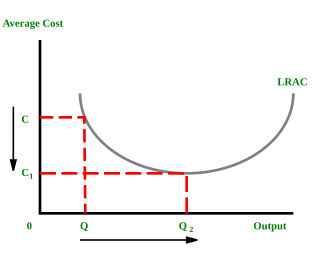Related Research Articles

In microeconomics, economies of scale are the cost advantages that enterprises obtain due to their scale of operation, and are typically measured by the amount of output produced per unit of time. A decrease in cost per unit of output enables an increase in scale that is, increased production with lowered cost. At the basis of economies of scale, there may be technical, statistical, organizational or related factors to the degree of market control.

Microeconomics is a branch of economics that studies the behavior of individuals and firms in making decisions regarding the allocation of scarce resources and the interactions among these individuals and firms. Microeconomics focuses on the study of individual markets, sectors, or industries as opposed to the national economy as a whole, which is studied in macroeconomics.

Mass production, also known as flow production, series production or continuous production, is the production of substantial amounts of standardized products in a constant flow, including and especially on assembly lines. Together with job production and batch production, it is one of the three main production methods.
Fordism is an industrial engineering and manufacturing system that serves as the basis of modern social and labor-economic systems that support industrialized, standardized mass production and mass consumption. The concept is named after Henry Ford. It is used in social, economic, and management theory about production, working conditions, consumption, and related phenomena, especially regarding the 20th century. It describes an ideology of advanced capitalism centered around the American socioeconomic systems in place in the post-war economic boom.

In microeconomics, a production–possibility frontier (PPF), production possibility curve (PPC), or production possibility boundary (PPB) is a graphical representation showing all the possible options of output for two goods that can be produced using all factors of production, where the given resources are fully and efficiently utilized per unit time. A PPF illustrates several economic concepts, such as allocative efficiency, economies of scale, opportunity cost, productive efficiency, and scarcity of resources.

Temporary work or temporary employment refers to an employment situation where the working arrangement is limited to a certain period of time based on the needs of the employing organization. Temporary employees are sometimes called "contractual", "seasonal", "interim", "casual staff", "outsourcing", "freelance"; or the words may be shortened to "temps". In some instances, temporary, highly skilled professionals refer to themselves as consultants. Increasingly, executive-level positions are also filled with interim executives or fractional executives.

Chemainus is a community within the municipality of North Cowichan in the Chemainus Valley on the east coast of southern Vancouver Island, British Columbia, Canada.
The engine of Japanese economic growth has been private initiative and enterprise, together with strong support and guidance from the government and from labor. The most numerous enterprises were single proprietorships, of which there were more than 4 million in the late 1980s. The dominant form of organization, however, is the corporation. In 1988 some 2 million corporations employed more than 30 million workers, or nearly half of the total labor force of 60.1 million people. Corporations range from large to small, but the favored type of organization is the joint-stock company, with directors, auditors, and yearly stockholders' meetings.
Vertical disintegration refers to a specific organizational form of industrial production. As opposed to vertical integration, in which production occurs within a singular organization, vertical disintegration means that various diseconomies of scale or scope have broken a production process into separate companies, each performing a limited subset of activities required to create a finished product.
The regulation school is a group of writers in political economy and economics whose origins can be traced to France in the early 1970s, where economic instability and stagflation were rampant in the French economy. The term régulation was coined by Frenchman Destanne de Bernis, who aimed to use the approach as a systems theory to bring Marxian economic analysis up to date. These writers are influenced by structural Marxism, the Annales School, institutionalism, Karl Polanyi's substantivist approach, and theory of Charles Bettelheim, among others, and sought to present the emergence of new economic forms in terms of tensions within existing arrangements. Since they are interested in how historically specific systems of capital accumulation are "regularized" or stabilized, their approach is called the "regulation approach" or "regulation theory". Although this approach originated in Michel Aglietta's monograph A Theory of Capitalist Regulation: The US Experience and was popularized by other Parisians such as Robert Boyer, its membership goes well beyond the so-called Parisian School, extending to the Grenoble School, the German School, the Amsterdam School, British radical geographers, the US Social Structure of Accumulation School, and the neo-Gramscian school, among others.
Investment-specific technological progress refers to progress that requires investment in new equipment and structures embodying the latest technology in order to realize its benefits. To model the influence of technological change upon production the influence of a technological change upon the specific inputs of a production model is assessed in terms of the resulting effect upon the final good of the model.
The term "mass market" refers to a market for goods produced on a large scale for a significant number of end consumers. The mass market differs from the niche market in that the former focuses on consumers with a wide variety of backgrounds with no identifiable preferences and expectations in a large market segment. Traditionally, businesses reach out to the mass market with advertising messages through a variety of media including radio, TV, newspapers and the Web.
The digital economy is a portmanteau of digital computing and economy, and is an umbrella term that describes how traditional brick-and-mortar economic activities are being transformed by the Internet and World Wide Web technologies.
Service innovation is used to refer to many things. These include but not limited to:
- Innovation in services, in service products – new or improved service products. Often this is contrasted with “technological innovation”, though service products can have technological elements. This sense of service innovation is closely related to service design and "new service development".
- Innovation in service processes – new or improved ways of designing and producing services. This may include innovation in service delivery systems, though often this will be regarded instead as a service product innovation. Innovation of this sort may be technological, technological - or expertise -based, or a matter of work organization.
- Innovation in service firms, organizations, and industries – organizational innovations, as well as service product and process innovations, and the management of innovation processes, within service organizations.
Economic restructuring is used to indicate changes in the constituent parts of an economy in a very general sense. In the western world, it is usually used to refer to the phenomenon of urban areas shifting from a manufacturing to a service sector economic base. It has profound implications for productive capacities and competitiveness of cities and regions. This transformation has affected demographics including income distribution, employment, and social hierarchy; institutional arrangements including the growth of the corporate complex, specialized producer services, capital mobility, informal economy, nonstandard work, and public outlays; as well as geographic spacing including the rise of world cities, spatial mismatch, and metropolitan growth differentials.

The following outline is provided as an overview of and topical guide to economics:
Cognitive-cultural economy or cognitive-cultural capitalism is represented by sectors such as high-technology industry, business and financial services, personal services, the media, the cultural industries. It is characterized by digital technologies combined with high levels of cognitive and cultural labor.
The sharing economy is a socio-economic system whereby consumers share in the creation, production, distribution, trade and consumption of goods, and services. These systems take a variety of forms, often leveraging information technology and the Internet, particularly digital platforms, to facilitate the distribution, sharing and reuse of excess capacity in goods and services.
This glossary of economics is a list of definitions of terms and concepts used in economics, its sub-disciplines, and related fields.
Inframarginal analysis is an analytical method in the study of classical economics. Xiaokai Yang created the super marginal analysis method and revived the important thought of division of labour of Adam Smith. The new classical economics reconstructs several independent economic theories with the core of neoclassical economics from the perspective of endogenous individual choice specialization level by means of inframarginal analysis, which is the frontier subject of economics development.
References
- Amin, Ash (1994). Post-fordism: A Reader. Blackwell Publishing. ISBN 0-631-18857-6.
- Baca, George (2004) "Legends of Fordism: Between Myth, History, and Foregone Conclusions," Social Analysis,48(3): 169–178.
- Jessop, Bob (1995). The Regulation Approach, Governance and Post-fordism, Economy and Society. Blackwell Publishing. ISBN 0-631-18857-6.
- Alain Lipietz (Spring 1997). "The Post Fordist World: Labor Relations, International Hierarchy and Global Ecology". Review of International Political Economy: 1–41.
- Kumar, Krishan (1995). N. From Post-Industrial to Post-Modern Society: New Theories of the Contemporary World . Blackwell Publishing. ISBN 0-631-18559-3.
- Ray Kiely (Spring 1998). "Globalization, Post-Fordism and the Contemporary Context of Development". International Sociology. 13 (1): 95–111. doi:10.1177/026858098013001008. S2CID 145754520.
- Milani, Brian (2000). Designing the Green Economy: The Postindustrial Alternative to Corporate Globalization. Rowman and Littlefield. ISBN 0-8476-9190-X.
- Bernard, Mitchell (2000). "Post-Fordism and Global Restructuring". In Stubbs, Richard; Geoffrey R.D. Underhill (eds.). Political Economy and the Changing Global Order. Oxford University Press Canada.
- Nilges, Mathias (2008). "The Anti-Anti-Oedipus: Representing Post-Fordist Subjectivity". Mediations Journal.
- Gielen, Pascal (2015 - 3rd ed.), The Murmuring of the Artistic Multitude. Global Art, Politics and Post-Fordism. Valiz: Amsterdam, ISBN 9789492095046